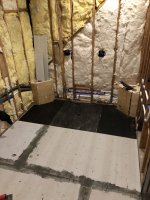Tony31
New Member
Searched a lot for any discussion on this topic and found the proper mortar thickness but not much discussion on what happens if you don't follow the manufacturers instructions. I know that the manufacturer required mortar thickness under the Kerdi drain on wooden sub-floor is 1" and on concrete its less because it provides more support.
However, In my shower I am able to achieve a curbless shower if I slope my mortar bed to 0" under the Kerdi flange and screw the flange to the wooden sub-floor. My wooden sub-floor is 3/4" plywood with a 12" span and the drain is very close to a double-wide 2x10 floor joist. It seems like this would provide more than adequate support for the drain to avoid any future structural issues.
My question is... am I taking too much risk on the structural support for the reward of a fully curbless shower? Has anyone installed these Kerdi flanges direct to sub-floor? I am not worried about the manufacturers warranty at all but I am worried about whether this will work.
P.S. I am not going to lower the sub-floor any further because I would require an engineer to review the floor joist modifications and I don't want to deal with that. I would rather live with a 1" lip into the shower than lower the sub-floor.
However, In my shower I am able to achieve a curbless shower if I slope my mortar bed to 0" under the Kerdi flange and screw the flange to the wooden sub-floor. My wooden sub-floor is 3/4" plywood with a 12" span and the drain is very close to a double-wide 2x10 floor joist. It seems like this would provide more than adequate support for the drain to avoid any future structural issues.
My question is... am I taking too much risk on the structural support for the reward of a fully curbless shower? Has anyone installed these Kerdi flanges direct to sub-floor? I am not worried about the manufacturers warranty at all but I am worried about whether this will work.
P.S. I am not going to lower the sub-floor any further because I would require an engineer to review the floor joist modifications and I don't want to deal with that. I would rather live with a 1" lip into the shower than lower the sub-floor.

